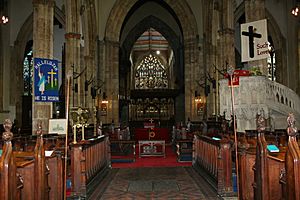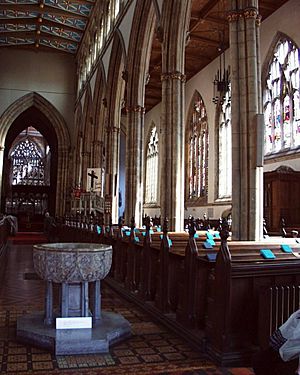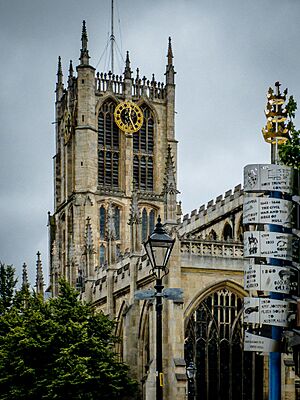Hull Minster facts for kids
Quick facts for kids Hull Minster |
|
|---|---|
| Holy Trinity Church | |

Hull Minster
|
|
| OS grid reference | TA 09963 28554 |
| Country | England |
| Denomination | Church of England |
| Previous denomination | Catholic Church |
| History | |
| Status | Minster |
| Dedication | Holy Trinity |
| Architecture | |
| Style | Perpendicular Gothic |
| Years built | c. 1285 transepts 1300–20 choir 1340–70 nave 1380–1420 tower 1490–1520 |
| Specifications | |
| Length | 285 feet (87 m) |
| Nave width | 72 feet (22 m) |
| Tower height | 150 feet (46 m) |
| Administration | |
| Parish | The Most Holy and Undivided Trinity Kingston upon Hull |
| Benefice | Kingston upon Hull Holy Trinity |
| Deanery | Kingston upon Hull |
| Archdeaconry | East Riding |
| Diocese | Diocese of York |
| Province | Province of York |
Hull Minster is a very old and important church in Kingston upon Hull, England. It used to be called Holy Trinity Church. On May 13, 2017, it was given a special new name, Hull Minster. This means it's a church with a long history and a big role in the community.
Contents
History of Hull Minster
Hull Minster has been around for a very long time. Different parts of the church were built at different times.
- The transepts (the arms of the cross-shaped church) were built around 1300 to 1320.
- The choir (where the singers sit) was built between 1340 and 1370.
- The nave (the main part where people sit) was built from 1380 to 1420.
- The tower was added later, between 1490 and 1520.
In the 1700s, some of the brickwork was covered up. But in the 1840s, a big restoration project cleaned it up. They also removed old galleries and pews. New oak seats were added, carved by George Peck of Hull. The ceiling was painted blue, with beams in crimson and gold.
A very famous person, William Wilberforce, was baptised here in 1759. He was important for leading the fight against the slave trade.
Restoration and Changes
From 1861 to 1878, the church had another major restoration. This work was led by a famous architect named Sir George Gilbert Scott. It cost a lot of money, about £32,750 at the time.
In 1906, engineers found that the tower was in danger. They had to do emergency work to make it safe again. This involved putting concrete under the church and rebuilding parts of the nave.
Hull Minster was very lucky during the Hull Blitz in both World Wars. Hull was heavily bombed, but the church managed to escape serious damage.
In 2014, plans were made to make the church even better. The idea was to create a great space for concerts, art shows, and events. It would also be a place where people could find help. This project aimed to help Hull's Old Town become a lively place again. The changes cost about £4.5 million and were ready for Hull's year as UK City of Culture in 2017.
On November 7, 2016, the Archbishop of York, John Sentamu, announced that the church would become a Minster. This special ceremony happened on May 13, 2017.
In March 2019, the Minster received a large grant of £3.9 million. This money helped create a new visitor centre, a café, and exhibition areas.
Hull Minster Today
Hull Minster is the largest parish church in England based on its floor area. It has some of the best medieval brickwork in the country, especially in its transepts. The church is a Grade I listed building, which means it's a very important historic building.
As of 2025, the church has three ordained ministers and a team of support staff. It is also part of the Greater Churches Group, which includes other large and important parish churches.
The Tower
The tower of Hull Minster is a key part of the building. It holds the church's clock and bells.
The Clock
The first clock in the tower was built in 1772 by Joseph Hindley. It only had one face.
In 1840, James Harrison IV put in a new clock. This one had four large faces, each about 13.25 feet (4 meters) wide. At the time, these were the biggest parish church clock faces in England! The minute hand was over 9 feet (2.8 meters) long, and the hour hand was over 8 feet (2.5 meters) long.
This clock mechanism was replaced in 1913 by Potts of Leeds. The new clock plays the Cambridge Chimes. The large clock faces from 1840 were kept.
The Chimes and Bells
The first set of chimes was installed in 1777. It played several tunes and had to be wound twice a day. These chimes were restored a few times. In 1898, the bells they chimed on were removed and recast.
A new set of chimes was put in with the new clock in 1913.
In May 2013, a chime of 15 bells was installed. More bells were added in 2014 and 2017, bringing the total to 25 bells. These chimes can be played using a digital control box or manually from a keyboard.
Besides the chimes, the tower also has 12 bells for change ringing. Ten of these bells are from 1899, and two are from 1959. All of them were made by John Taylor of Loughborough.
The Organ
Hull Minster has a very impressive organ. Records from the 1620s mention that the church had organs that needed to be restored.
The first organ after the English Civil War was built around 1711-1712 by "Father" Smith. This organ was originally made for St Paul's Cathedral in London but was too small for that huge building. It was later made even bigger by John Snetzler.
Over the years, new organs were built and old ones were enlarged. The current organ is very large, with 4 keyboards and 104 "speaking stops" (which control the different sounds). It was built by the John Compton Organ Company in 1938.
You can find more details about the organ on the National Pipe Organ Register.
See also
 In Spanish: Hull Minster para niños
In Spanish: Hull Minster para niños
Images for kids


































